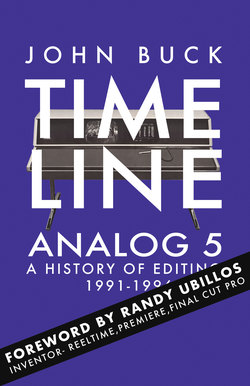Читать книгу Timeline Analog 5 - John Buck - Страница 6
На сайте Литреса книга снята с продажи.
Preface
ОглавлениеIn the spring of 1924, a small Germany company Lyta Cinema Works built the first dedicated editing device. A few months later the American made Moviola went on sale in Hollywood and become a huge success but it was sixty five years before a digital equivalent arrived for professionals.
In the intervening years individuals, and teams imagined tools that could join images together in the blink of an eye.
They trialled technology, experimented with the impossible, quit secure jobs for the unknown, and ran out of money. All the while, they tried to ship the best editing product possible.
For many years their stories went untold.
Hoping to solve an amicable dispute with Boris Yamnitsky, who had just acquired Media 100, I found myself at the local library staring at books that talked about 'how to' edit but not how editing came to be. My casual conversation was now a niggling annoyance.
I turned to the web and found two names listed in submissions to the U.S Patent Office about electronic editing. Adrian Ettlinger and William Warner.
One had created something called the CBS RAVE, and the other, Avid. They graciously took my phone calls, retold stories of electronic editing’s rich history, and connected me with lesser known individuals who had created the tools we use today.
Adrian and Bill not only helped, but they actively encouraged me. Bill made time to talk, linked me to others and poured me coffee in his kitchen. Adrian braved the wet streets of Manhattan to tell me, over lunch at the Chiam, about a remarkable period of innovation.
My part-time quest changed again when two key contributors passed away.
Art Schneider and Jack Calaway both made huge contributions to editing, yet their efforts had gone largely unheralded. I decided to record the history of editing because it fades. Timeline zigs and zags from people to places, within companies, across continents. People's lives rarely run from A to B.
Former Xerox scientist David Canfield Smith told me: “In any revolution, technological or otherwise, there are interesting characters. In fact, the characters often are the story”.
